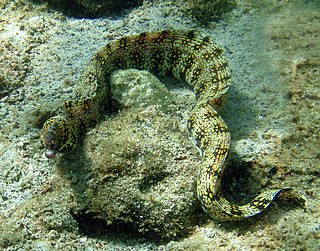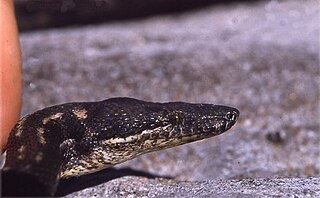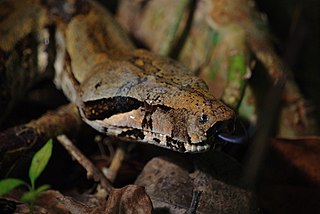
The clouded leopard, also called mainland clouded leopard, is a wild cat inhabiting dense forests from the foothills of the Himalayas through Northeast India and Bhutan to mainland Southeast Asia into South China. It was first described in 1821 on the basis of a skin of an individual from China. The clouded leopard has large dusky-grey blotches and irregular spots and stripes reminiscent of clouds. Its head-and-body length ranges from 68.6 to 108 cm with a 61 to 91 cm long tail. It uses its tail for balancing when moving in trees and is able to climb down vertical tree trunks head first. It rests in trees during the day and hunts by night on the forest floor.

Neofelis is a genus comprising two extant cat species in Southeast Asia: the clouded leopard of mainland Asia, and the Sunda clouded leopard of Sumatra and Borneo.

The great grey owl is a true owl, and is the world's largest species of owl by length. It is distributed across the Northern Hemisphere, and it is the only species in the genus Strix found in both Eastern and Western Hemispheres. In some areas it is also called the Phantom of the North, cinereous owl, spectral owl, Lapland owl, spruce owl, bearded owl, and sooty owl.

Boa is a genus of boas found in Mexico, the Caribbean, and Central and South America. Five extant species, and one extinct, are currently recognized.

The Formosan clouded leopard is a clouded leopard population that was endemic to Taiwan. Camera trapping studies carried out in several protected areas in Taiwan between 1997 and 2012 did not record any clouded leopard. The population is listed as extinct on the IUCN Red List.

The Calabar python is a species of non-venomous snake in the family Boidae. The species is endemic to West and Central Africa. It is the only species in its genus.

The Pantherinae is a subfamily of the Felidae; it was named and first described by Reginald Innes Pocock in 1917 as only including the Panthera species, but later also came to include the clouded leopards. The Pantherinae genetically diverged from a common ancestor between 9.32 to 4.47 million years ago and 10.67 to 3.76 million years ago.

The mottled eel, also known as the African mottled eel, the Indian longfin eel, the Indian mottled eel, the long-finned eel or the river eel, is a demersal, catadromous eel in the family Anguillidae. It was described by John McClelland in 1844. It is a tropical, freshwater eel which is known from East Africa, Bangladesh, Andaman Islands, Mozambique, Malawi, Sri Lanka, Sumatra, and Indonesia and recently from Madagascar. The eels spend most of their lives in freshwater at a depth range of 3–10 metres, but migrate to the Indian Ocean to breed. Males can reach a maximum total length of 121 centimetres and a maximum weight of 7,000 grams. The eels feed primarily off of benthic crustaceans, mollusks, finfish and worms.

The boa catshark is a catshark of the family Scyliorhinidae. It is found on the continental shelves and insular slopes of the Caribbean Sea and the Gulf of Mexico, between latitudes 20° N and 9° N, at depths between 330 and 675 m. It can grow up to a length of 54 cm. The reproduction of this catshark is oviparous.

The clouded angelshark is an angelshark of the family Squatinidae found in the northwest Pacific from the southeastern Sea of Japan to Taiwan between latitudes 47° N and 22° N. Its length is up to 1.63 m.

The snowflake moray, also known as the clouded moray among many vernacular names, is a species of marine eel of the family Muraenidae. It has blunt teeth ideal for its diet of crustaceans, a trait it shares with the zebra moray.

The Cozumel harvest mouse is a species of rodent in the family Cricetidae. It is endemic to the Mexican island of Cozumel off the Yucatán Peninsula. It is nocturnal and semiarboreal, and lives in dense secondary forest and forest edge habitats. Its population is small, fluctuating and patchily distributed. The species is threatened by predation from feral cats and dogs and introduced boa constrictors, by competition with introduced nonnative rats and mice, and by habitat disturbances caused by hurricanes and floods which periodically strike the island.

The Samoan fantail is a species of bird in the family Rhipiduridae. It is endemic to Samoa and is found in Upolu and Savaiʻi islands.

The Round Island boa, also known commonly as the Round Island keel-scaled boa and the Round Island ground boa, is a species of nonvenomous snake in the monotypic genus Casarea in the family Bolyeriidae. The species is endemic to Round Island, Mauritius. No subspecies are currently recognized.
Manettia nebulosa is a species of plant in the family Rubiaceae. It is endemic to Ecuador.

Boa orophias, the Saint Lucia boa or San Lucia boa, is a species of snake in the family Boidae. The species is endemic to Saint Lucia. Boa orophias was described as a full species by Carl Linnaeus in 1758, but many later authors have classified it as a subspecies of Boa constrictor. According to the IUCN Red List, Boa orophias is a species, which they have listed as Endangered.

Chilabothrus striatus, the Hispaniolan boa, is a species of snake in the family Boidae. The species is endemic to Hispaniola. The species is regularly found in the international pet trade.

The boa constrictor, also known as the common boa, is a species of large, non-venomous, heavy-bodied snake that is frequently kept and bred in captivity. The boa constrictor is a member of the family Boidae. The species is native to tropical South America. A staple of private collections and public displays, its color pattern is highly variable yet distinctive. Four subspecies are recognized.

Diplacodes nebulosa is a species of dragonfly in the family Libellulidae. It is a widely distributed species in many Asian countries. and northern Australia.

Parapercis nebulosa, the barred sandperch, is a species of ray-finned fish in the sandperch family, Pinguipedidae. It is found off the coast of Australia.




















